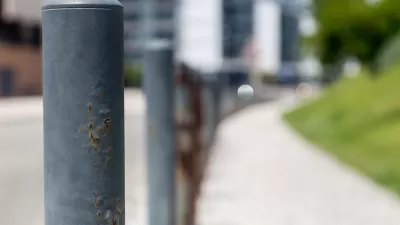Strategies for securing public spaces from vehicle attacks and other acts of terrorism without sacrificing accessible, vibrant urban places.

How can cities better protect people in public spaces from vehicle attacks and other threats? Writing in Bloomberg CityLab, John Surico attempts to unpack this question in the wake of the deadly attack in New Orleans, in which a truck was used to kill over a dozen people as protective bollards were being replaced.
According to Rob Reiter, a security consultant who specializes in vehicle attacks, says cities should more carefully evaluate potential “collision points” where pedestrian-heavy corridors intersect with roadways open to vehicle traffic. Reiter points to New York City’s low-tech intervention for New Year’s Eve: “dozens of garbage and dump trucks laden with sand, parked bumper-to-bumper to block any intrusions,” providing a practically impenetrable perimeter.
Outside of special events, cities can use “sculptural barriers,” trees, and other decorative — but solid — items to create a “positive perimeter” that offers protection without creating a hostile environment.
Surico concludes that “The long-term benefits of security improvements can’t necessarily be counted in just lives saved. Just as a community that’s more hospitable to older adults or children is more hospitable to everyone else, too, making spaces better protected from vehicle attacks can also just make them better, period.”
FULL STORY: What Can Cities Do to Protect Public Spaces From Vehicle Attacks?

Planetizen Federal Action Tracker
A weekly monitor of how Trump’s orders and actions are impacting planners and planning in America.

Congressman Proposes Bill to Rename DC Metro “Trump Train”
The Make Autorail Great Again Act would withhold federal funding to the system until the Washington Metropolitan Area Transit Authority (WMATA), rebrands as the Washington Metropolitan Authority for Greater Access (WMAGA).

The Simple Legislative Tool Transforming Vacant Downtowns
In California, Michigan and Georgia, an easy win is bringing dollars — and delight — back to city centers.

The States Losing Rural Delivery Rooms at an Alarming Pace
In some states, as few as 9% of rural hospitals still deliver babies. As a result, rising pre-term births, no adequate pre-term care and harrowing close calls are a growing reality.

The Small South Asian Republic Going all in on EVs
Thanks to one simple policy change less than five years ago, 65% of new cars in this Himalayan country are now electric.

DC Backpedals on Bike Lane Protection, Swaps Barriers for Paint
Citing aesthetic concerns, the city is removing the concrete barriers and flexposts that once separated Arizona Avenue cyclists from motor vehicles.
Urban Design for Planners 1: Software Tools
This six-course series explores essential urban design concepts using open source software and equips planners with the tools they need to participate fully in the urban design process.
Planning for Universal Design
Learn the tools for implementing Universal Design in planning regulations.
Smith Gee Studio
City of Charlotte
City of Camden Redevelopment Agency
City of Astoria
Transportation Research & Education Center (TREC) at Portland State University
US High Speed Rail Association
City of Camden Redevelopment Agency
Municipality of Princeton (NJ)




























